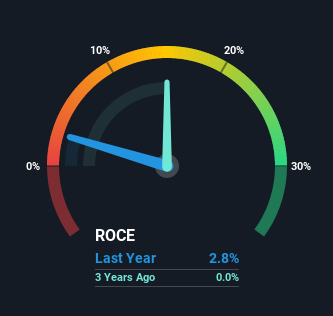There Are Reasons To Feel Uneasy About Dalrymple Bay Infrastructure's (ASX:DBI) Returns On Capital
If you're not sure where to start when looking for the next multi-bagger, there are a few key trends you should keep an eye out for. Amongst other things, we'll want to see two things; firstly, a growing return on capital employed (ROCE) and secondly, an expansion in the company's amount of capital employed. Put simply, these types of businesses are compounding machines, meaning they are continually reinvesting their earnings at ever-higher rates of return. Although, when we looked at Dalrymple Bay Infrastructure (ASX:DBI), it didn't seem to tick all of these boxes.
What is Return On Capital Employed (ROCE)?
If you haven't worked with ROCE before, it measures the 'return' (pre-tax profit) a company generates from capital employed in its business. To calculate this metric for Dalrymple Bay Infrastructure, this is the formula:
Return on Capital Employed = Earnings Before Interest and Tax (EBIT) ÷ (Total Assets - Current Liabilities)
0.028 = AU$93m ÷ (AU$3.5b - AU$97m) (Based on the trailing twelve months to June 2021).
Therefore, Dalrymple Bay Infrastructure has an ROCE of 2.8%. Ultimately, that's a low return and it under-performs the Infrastructure industry average of 6.8%.
View our latest analysis for Dalrymple Bay Infrastructure
Above you can see how the current ROCE for Dalrymple Bay Infrastructure compares to its prior returns on capital, but there's only so much you can tell from the past. If you'd like to see what analysts are forecasting going forward, you should check out our free report for Dalrymple Bay Infrastructure.
What Can We Tell From Dalrymple Bay Infrastructure's ROCE Trend?
In terms of Dalrymple Bay Infrastructure's historical ROCE movements, the trend isn't fantastic. To be more specific, ROCE has fallen from 6.6% over the last one year. Given the business is employing more capital while revenue has slipped, this is a bit concerning. If this were to continue, you might be looking at a company that is trying to reinvest for growth but is actually losing market share since sales haven't increased.
On a side note, Dalrymple Bay Infrastructure has done well to pay down its current liabilities to 2.8% of total assets. So we could link some of this to the decrease in ROCE. Effectively this means their suppliers or short-term creditors are funding less of the business, which reduces some elements of risk. Some would claim this reduces the business' efficiency at generating ROCE since it is now funding more of the operations with its own money.
Our Take On Dalrymple Bay Infrastructure's ROCE
In summary, we're somewhat concerned by Dalrymple Bay Infrastructure's diminishing returns on increasing amounts of capital. And, the stock has remained flat over the last year, so investors don't seem too impressed either. With underlying trends that aren't great in these areas, we'd consider looking elsewhere.
If you'd like to know about the risks facing Dalrymple Bay Infrastructure, we've discovered 2 warning signs that you should be aware of.
While Dalrymple Bay Infrastructure may not currently earn the highest returns, we've compiled a list of companies that currently earn more than 25% return on equity. Check out this free list here.
Have feedback on this article? Concerned about the content? Get in touch with us directly. Alternatively, email editorial-team (at) simplywallst.com.
This article by Simply Wall St is general in nature. We provide commentary based on historical data and analyst forecasts only using an unbiased methodology and our articles are not intended to be financial advice. It does not constitute a recommendation to buy or sell any stock, and does not take account of your objectives, or your financial situation. We aim to bring you long-term focused analysis driven by fundamental data. Note that our analysis may not factor in the latest price-sensitive company announcements or qualitative material. Simply Wall St has no position in any stocks mentioned.

 Yahoo Finance
Yahoo Finance 
